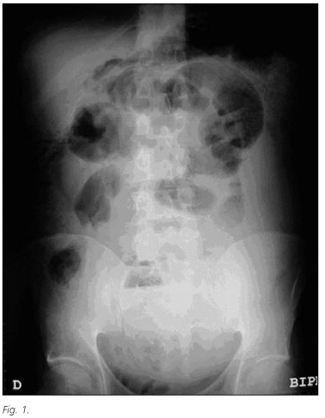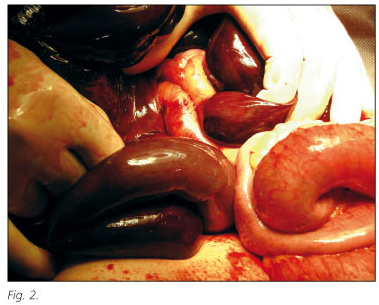My SciELO
Services on Demand
Journal
Article
Indicators
-
 Cited by SciELO
Cited by SciELO -
 Access statistics
Access statistics
Related links
-
 Cited by Google
Cited by Google -
 Similars in
SciELO
Similars in
SciELO -
 Similars in Google
Similars in Google
Share
Revista Española de Enfermedades Digestivas
Print version ISSN 1130-0108
Rev. esp. enferm. dig. vol.101 n.6 Madrid Jun. 2009
LETTERS TO THE EDITOR
Gangrened ileosigmoid knot
Nudo ileosigmoideo gangrenado
Key words: Ileosigmoid knot. Intestinal knot.
Palabras clave: Nudo ileosigmoideo. Nudo intestinal.
Dear Editor,
Mechanical intestinal obstruction with closed double loop phenomenon secondary to knotting of the mesentery, known as ileosigmoid knot, is an uncommon entity that can rapidly evolve into ischemia of the intestinal segments that form the knot. It originates with the wrapping of the mobile ileum loops and the sigma, generally redundant, compromising the meso in the center of the knot. It is an unusual cause of intestinal obstruction in the western world and relatively common in some countries of Asia, Africa and the Middle East. Early diagnosis is difficult due to the unspecificity of the radiologic sings, its rapid evolution, and because it is a relatively rare condition.
Clinical case
35-year-old male without previous diseases admitted to the Emergency department after a one-day history of nausea, vomiting and intense, brisk crampy abdominal pain. On the examination he had no fever and was dehydrated. His abdomen was defended and lightly distended with guarding and reduced bowel sounds. Bloods showed a white cell count of 12.4 x 109/L with neutrophilia and metabolic acidosis. An abdominal X-ray showed several distended loops without pneumoperitoneum. Abdominal echography reported abdominal distension with distended intestinal loops. The patient underwent an emergency laparotomy (Fig. 1). At operation a dark bloody fluid was encountered with gross distension of intestinal loops and the colon with ischaemic color change in the ileum and the sigma forming an ileosigmoid knot (Fig. 2). Needle decompression of the distended loops was done with posterior resection of the ileum and sigmoid segments affected. The patient had a favorable evolution despite the extensive ileocolic necrosis.
Discussion
The ileosigmoid knot is an infrequent surgical emergency that can rapidly evolve to gangrene of the ileum and sigmoid segments affected. This condition was originally reported by Parker in 1845 in a patient with an intestinal obstruction caused by knotting of an ileal loop in the base of the sigma. More common in males in the fourth decade of life and it clinically presents as a high intestinal obstruction with severe colicky abdominal pain, dehydration and vomiting. When gangrene is present, generally there is severe peritonitis with guarding, acidosis and shock. Early diagnosis is difficult do to its rarity and to the unspecifity of radiologic sings. Occasionally a closed double loop image is present with dilatation of the sigmoid colon and multiple air-fluid levels in multiple ileal loops. Computed axial tomography, CT scan may describe sings of sigmoid volvulus, ischemia, pneumatosis and the "whirl" image created by the twisted intestine and mesentery.
Several factors condition the nature of the ileosigmoid knot formation. Anatomically there are two considerations, first a freely mobile small intestine with a long and thin mesentery. Second a long and redundant sigmoid colon on a narrow mesentery. Dietary factors also plays a roll in it's etiology, consumption of a high bulk diet in an empty small intestine can predispose ileosigmoid knot formation. In a series of 92 patients with ileosigmoid knotting Shepherd reported this phenomenon occurring in Bagandans of Uganda who eat only once a day. Alver classifies ileosigmoid knots in four types, our patient had type undetermined in witch it's not possible to determine the active component. Once the knot is formed an intestinal occlusion and the increasing peristalsis closes the knot rapidly twisting the mesentery and compromising the irrigation of the involved segments. When all segments are viable untying the knot may be enough since recurrence is uncommon. Other recommend sigmoidectomy in all cases even if the sigma is viable, avoiding this way any recurrence. When irreversible ischemia is present needle or controlled enterotomy decompression should be done prior to en bloc resection of the gangrened segments. Manipulation of the knot with intention of untying it is not recommended because it carries a high risk of perforation. Ounce the necrotic ileum is extirpated a primary end to end anastomosis of the small bowel should be done if the distal ileum is not affected. On the other hand, if the distal ileum is viable or the remaining segment is closer to the ileocecal valve than a 10 cm a end to side ileocolic anastomosis is preferred. The decision of whether to perform a primary sigma anastomosis will depend on the patients conditions, in our patient due to the extensive necrosis a Hartmann's procedure was considered adequate leaving stumps prepared for a second operation, thus completing the two stage procedure.
C. Yánez Benítez, C. Casamayor Franco, L. Ligorred Padilla and F. Baque Sanz
Digestive and General Surgery Department. Hospital San Jorge. Huesca, Spain
References
1. Olcay A, Durkaya OM, Mustafa T, Bayram K, Dursun A. Ileosigmoid knotting in Turkey. Dis Colon Rectum 1993; 36: 1139-47. [ Links ]
2. Shaff MI, Himmelfarb E, Sacks GA, et al. The whirl sign: a CT finding in volvulus of the large bowel. J Comput Assist Tomogr 1984; 8: 559-91. [ Links ]
3. Alver O, Oren D, Tireli M, Kayabasi B, Akdemir D. Ileosigmoid knotting in Turkey. Review of 68 cases. Dis Colon Rectum 1993; 36: 1139-47. [ Links ]
4. Vaez-Zadeh K, Dutz W. Ileosigmoid knotting. Ann Surg 1970; 172: 1027-33. [ Links ]
5. Shepherd JJ. Ninety-two cases of ileosigmoid knotting in Uganda. Br J Surg 1967; 54: 561-6. [ Links ]
6. Wapnick S. Treatment of intestinal volvulus. Ann R Coll Surg Engl 1973; 53: 57-61. [ Links ]











 text in
text in 




